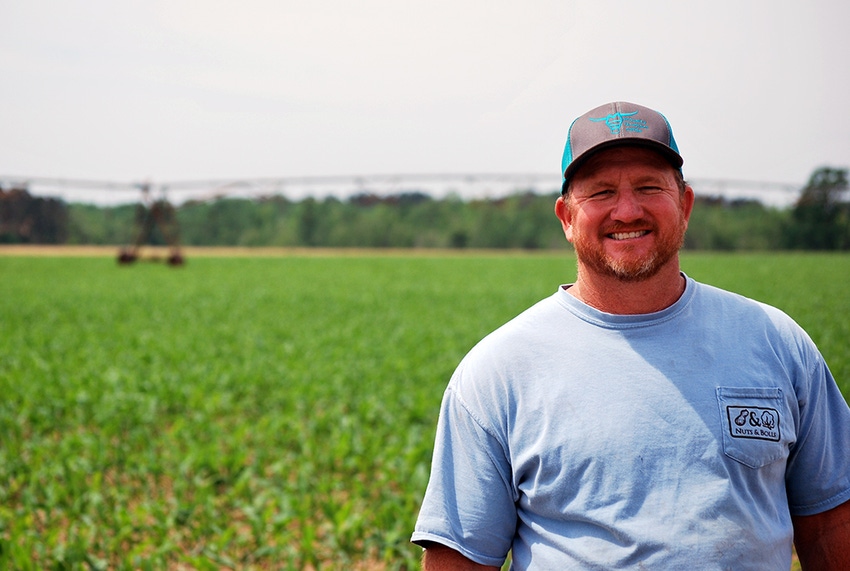
Jason Sauls had never harvested peanuts in January, but he did this year. That was different.
Sauls farms with his family in southwest Georgia’s Randolph County. History and tradition are grown there along with peanuts, cotton, corn and soybeans.
Sometimes in farming, like in poker, you don’t know what you’re going to get dealt on any particular hand. Sometimes you have an ace in the hole. Sometimes you try to stuff a few aces up your sleeves for later. Sometimes a great wind blows your hand, a good one or bad one, away. And then sometimes the skies open and rains deluge what’s left of the game.
EDITOR’S NOTE — This is the third article of a Southeast Farm Press editorial series called ‘Excellence in Peanuts — A 20th Anniversary,” which is exploring the last 20 years of U.S. peanut production through the lens of the peanut efficiency program past winners.
That’s pretty much what happened during the fall and winter in this corner of the southeast. Hurricane Michael wrought great destruction Oct. 10 across the region, but the record to near-record rain after the storm were almost as troubling, preventing harvest of what was left in fields and delaying field prep for this year.
The peanuts Sauls harvested Jan. 18 were dug the first week of December, the only time dry enough to get into the field. The yields were way off on those peanuts, about 3,000 pounds per acre. You could say the Sauls were way behind on getting all their peanuts harvested for 2018, or quip they were way ahead of schedule on harvesting 2019.
In farming, things change on a dime, while other things stay the same.
Peanut Award
Sauls and his family were the Farm Press Peanut Profitability Award winners for the lower Southeast in 2004. The program today is called the Peanut Efficiency Award and will celebrate its 20th class of winners this year at the Southern Peanut Growers Conference July 18.
SEFP got up with Sauls in mid-April to see how the past 15 years treated the family since its award recognition. All and all, things are going well for the family operation. Jason is still there farming with his brother, Guerry, and Uncle Jack Sauls. His father, Billy, now 80, and mother, Frankie, 75, are still on the farm, too, but they have eased out of the day-to-day decision making for the farm.
The Sauls operation 15 years ago was about 4,100 acres. They have since grown to about 6,700. They still grow peanuts. “We feel it is peanuts that brought us to the dance,” Jason said, adding that they still grow cotton, corn and soybeans and recently started growing snap beans and planted a pecan orchard.
Their peanut crop 15 years ago was about 75 percent irrigated. Today, their farm is almost 100 percent irrigated. They planted 15 years ago, like most farmers in the area, the Georgia Green peanut, the variety released through the University of Georgia breeding program that came along in time to help save runner peanut production from the industry-threatening tomato spotted wilt virus. Today, they grow the Georgia-06G variety.
Newer and Bigger
They now have larger equipment, running 12-row planters and harvesting and loading peanuts in the field on to semis instead of wagons. They still no-till corn and cotton and still use conventional-tillage for peanuts, and plant peanuts in a twin-row, eight-inch pattern. They stick to a three-year peanut rotation today, stretching to four years when then can, as they did 15 years ago. Back then, 5,000 pounds per acre was rockstar yields. Today, he said, they shoot for three tons per acre.
They have adapted to new technology over the last 15 years, the technology, Jason says, they can afford and that makes economic sense for their operation, which includes yield mapping and data collection, water sensors, and monitoring activity and data through smart phones and using some of the Ag Sense platform solutions.
Also, 15 years ago, the Sauls and other farmers didn’t know that a new paradigm was coming in the management of weeds. Herbicide-resistant pigweed was at the time a nasty rumor that soon became a full-on statewide problem for growers, who had to learn again how to do things differently and better. It taught growers like the Sauls family that timely diversified pesticide applications were essential to survival. Basing new practices on science-backed data from UGA Extension, they addressed the problem. The challenge was recognized and overcome.
Fifteen years ago, Jason Sauls was 32, and his son, Brett was 9. Brett recently graduated Auburn University with a degree in agricultural economics and is coming back to the farm to be a farmer this year, Sauls said. Sauls’ nephew Garrett, 27, is on the farm now, too, full time. The next generation is buying into the operation and contributing to the future of the family business.
“So, we are working to fit them into the operation and get them involved with enough incentives to keep them on the farm,” Jason said.
“The Sauls family partnership runs a state-of-the-art farm operation. They embrace modern technology and they are highly productive and sustainable in all the crops they produce. They are model representatives for southwest Georgia agriculture in that they are hardworking, multiple generation farmers, and great stewards of the land,” said Dr. Marshall Lamb, USDA agricultural economist and head of the National Peanut Lab in Dawson, Ga., not far from where the Sauls farm.
So 15 years from today, what would Jason Sauls like for the family operation to look like? He’d like for it to look like a family operation with his son and nephew stepping up to push the operation forward in their time, meeting and overcoming challenges, which will pop up.
Reading the feature story on the Sauls written 15 years ago by then SEFP editor Paul Hollis about their peanut award, one thing said in that story ironically rings true today. The federal peanut quota system had recently ended then, and in the story Jason mentions learning to market peanuts without the quota system and that they had contracted some of their 2005 crop for about $400 per ton.
Looking at today’s peanut market, well, you could say some things don’t change.
Previous winners of the Farm Press Peanut Profitability/Peanut Efficiency Award for the lower Southeast are:
Steve Moore (Ga.) – 2000
Harris Devane (Ga.) – 2001
Jerry and Jeff Heard (Ga.) 2002
Mike Newberry (Ga.) – 2003
Sauls Partnership (Ga.) – 2004
Fenn Farms (Ala.) – 2005
Drew Collins (Ga.) – 2006
Bob McLendon (Ga.) – 2007
Mike Nugent (Ga.) – 2008
T.E. Moye (Ga.) – 2009
Al Sudderth (Ga.) – 2010
Kreg Freeman (Ga.) -2011
I.C. Terry (Fla.) – 2012
Tim McMillan (Ga.) -2013
Owen Yoder (Ala.) – 2014
Johnny Cochran (Ga.) – 2015
Matt Bryan (Ga.) – 2016
Curry Parker (Ala.) – 2017
Jimmy Miller (Ala.) - 2018
About the Author(s)
You May Also Like






